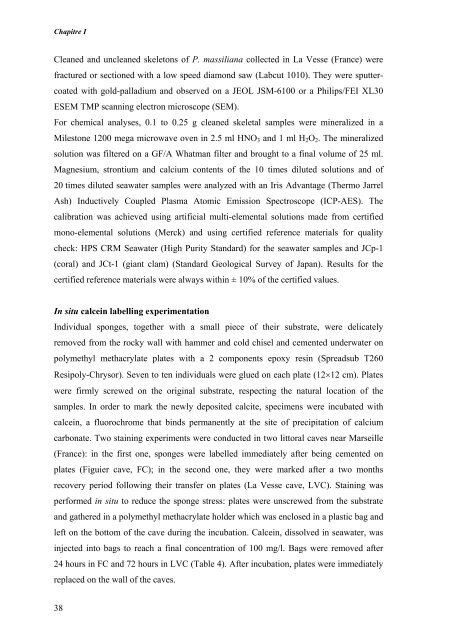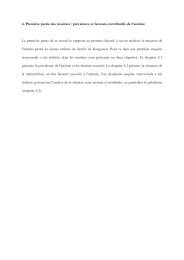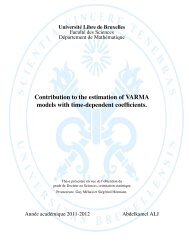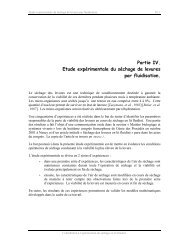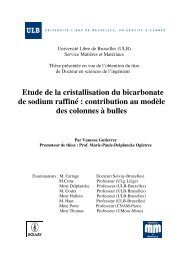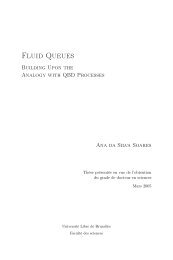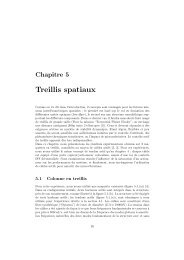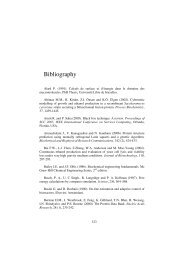Diapositive 1 - de l'Université libre de Bruxelles
Diapositive 1 - de l'Université libre de Bruxelles
Diapositive 1 - de l'Université libre de Bruxelles
Create successful ePaper yourself
Turn your PDF publications into a flip-book with our unique Google optimized e-Paper software.
Chapitre ICleaned and uncleaned skeletons of P. massiliana collected in La Vesse (France) werefractured or sectioned with a low speed diamond saw (Labcut 1010). They were sputtercoatedwith gold-palladium and observed on a JEOL JSM-6100 or a Philips/FEI XL30ESEM TMP scanning electron microscope (SEM).For chemical analyses, 0.1 to 0.25 g cleaned skeletal samples were mineralized in aMilestone 1200 mega microwave oven in 2.5 ml HNO 3 and 1 ml H 2 O 2 . The mineralizedsolution was filtered on a GF/A Whatman filter and brought to a final volume of 25 ml.Magnesium, strontium and calcium contents of the 10 times diluted solutions and of20 times diluted seawater samples were analyzed with an Iris Advantage (Thermo JarrelAsh) Inductively Coupled Plasma Atomic Emission Spectroscope (ICP-AES). Thecalibration was achieved using artificial multi-elemental solutions ma<strong>de</strong> from certifiedmono-elemental solutions (Merck) and using certified reference materials for qualitycheck: HPS CRM Seawater (High Purity Standard) for the seawater samples and JCp-1(coral) and JCt-1 (giant clam) (Standard Geological Survey of Japan). Results for thecertified reference materials were always within ± 10% of the certified values.In situ calcein labelling experimentationIndividual sponges, together with a small piece of their substrate, were <strong>de</strong>licatelyremoved from the rocky wall with hammer and cold chisel and cemented un<strong>de</strong>rwater onpolymethyl methacrylate plates with a 2 components epoxy resin (Spreadsub T260Resipoly-Chrysor). Seven to ten individuals were glued on each plate (12×12 cm). Plateswere firmly screwed on the original substrate, respecting the natural location of thesamples. In or<strong>de</strong>r to mark the newly <strong>de</strong>posited calcite, specimens were incubated withcalcein, a fluorochrome that binds permanently at the site of precipitation of calciumcarbonate. Two staining experiments were conducted in two littoral caves near Marseille(France): in the first one, sponges were labelled immediately after being cemented onplates (Figuier cave, FC); in the second one, they were marked after a two monthsrecovery period following their transfer on plates (La Vesse cave, LVC). Staining wasperformed in situ to reduce the sponge stress: plates were unscrewed from the substrateand gathered in a polymethyl methacrylate hol<strong>de</strong>r which was enclosed in a plastic bag andleft on the bottom of the cave during the incubation. Calcein, dissolved in seawater, wasinjected into bags to reach a final concentration of 100 mg/l. Bags were removed after24 hours in FC and 72 hours in LVC (Table 4). After incubation, plates were immediatelyreplaced on the wall of the caves.38


